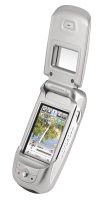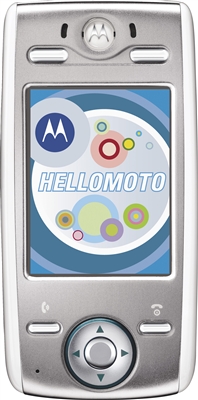Details emerge on Motorola’s cool Linux MP3 cameraphone
Apr 12, 2005 — by Henry Kingman — from the LinuxDevices Archive — views Motorola has revealed further details of its newly revised Linux-based MP3 player and cameraphone. The E680i adds support for stereo bluetooth audio connectivity, an improved interface with full HTML browser, and user-upgradable storage, Motorola says. Still lacking is quad-band GSM support, which would increase US usability.
Motorola has revealed further details of its newly revised Linux-based MP3 player and cameraphone. The E680i adds support for stereo bluetooth audio connectivity, an improved interface with full HTML browser, and user-upgradable storage, Motorola says. Still lacking is quad-band GSM support, which would increase US usability.
(Click for larger view of E680i)
Motorola announced the original E680 smartphone in March of 2004, and the phone has been available in China for some time. A recent review praised the device for its loud sound output (it has built-in stereo speakers), video capabilities, and Chinese character recognition, while lamenting the built-in camera's low VGA (640 x 480) resolution, and the lack of quad-band capabilities, which would have made it more useful in the US (for instance, by enabling it to work with Cingular's 850MHz GSM networks).
 According to Motorola, the “i” update to the E680 is still based on MontaVista Linux, Trolltech's Qt/Embedded graphics framework, and Sun's J2ME (Java 2 Micro Edition) Java virtual machine. However, the E680i features an interface similar to Motorola's A780 (pictured at right), another tri-band phone with limited US availability.
According to Motorola, the “i” update to the E680 is still based on MontaVista Linux, Trolltech's Qt/Embedded graphics framework, and Sun's J2ME (Java 2 Micro Edition) Java virtual machine. However, the E680i features an interface similar to Motorola's A780 (pictured at right), another tri-band phone with limited US availability.
Motorola's A780 is based on Intel's newest mobile multimedia processor, the XScale PXA270 (Bulverde). Motorola confirmed that the E680i is based on an Intel processor, but declined to offer further details. The company has also used the older XScale PXA255 in some of its Linux smartphones.


Motorola E680i, front and back
The E680i features an internal user storage capacity of “up to 50MB,” Motorola says, along with support for removable Transflash chips. These tiny, fingernail-sized memory expansion chips from Sandisk are meant for both internal and external use, and are intended to allow phone owners to upgrade their device's memory, much as they might upgrade a PC's memory or storage.
Additionally, the new E680i adds a full Opera mobile browser, which supports both WAP and HTML. And, the E680i adds support for bluetooth connectivity, enabling the phone to interface with home stereo hi-fi adapters, with in-car audio systems, and with stereo bluetooth headphones, Motorola says.
Despite the many new features, many US phone customers will probably rue the ongoing lack of support for the 850MHz band — the E680i, like the E680, remains a tri-band GSM phone that operates on the 900/1800/1900MHz bands. The E680i may be usable with some US GSM networks, however, such as Cingular's.
Motorola expects to ship eight to 10 new Linux smartphone models in 2005, according to a company official in Taiwan, as quoted by Taiwanese technology daily DigiTimes.
Additional details about the E680i are available here.
This article was originally published on LinuxDevices.com and has been donated to the open source community by QuinStreet Inc. Please visit LinuxToday.com for up-to-date news and articles about Linux and open source.